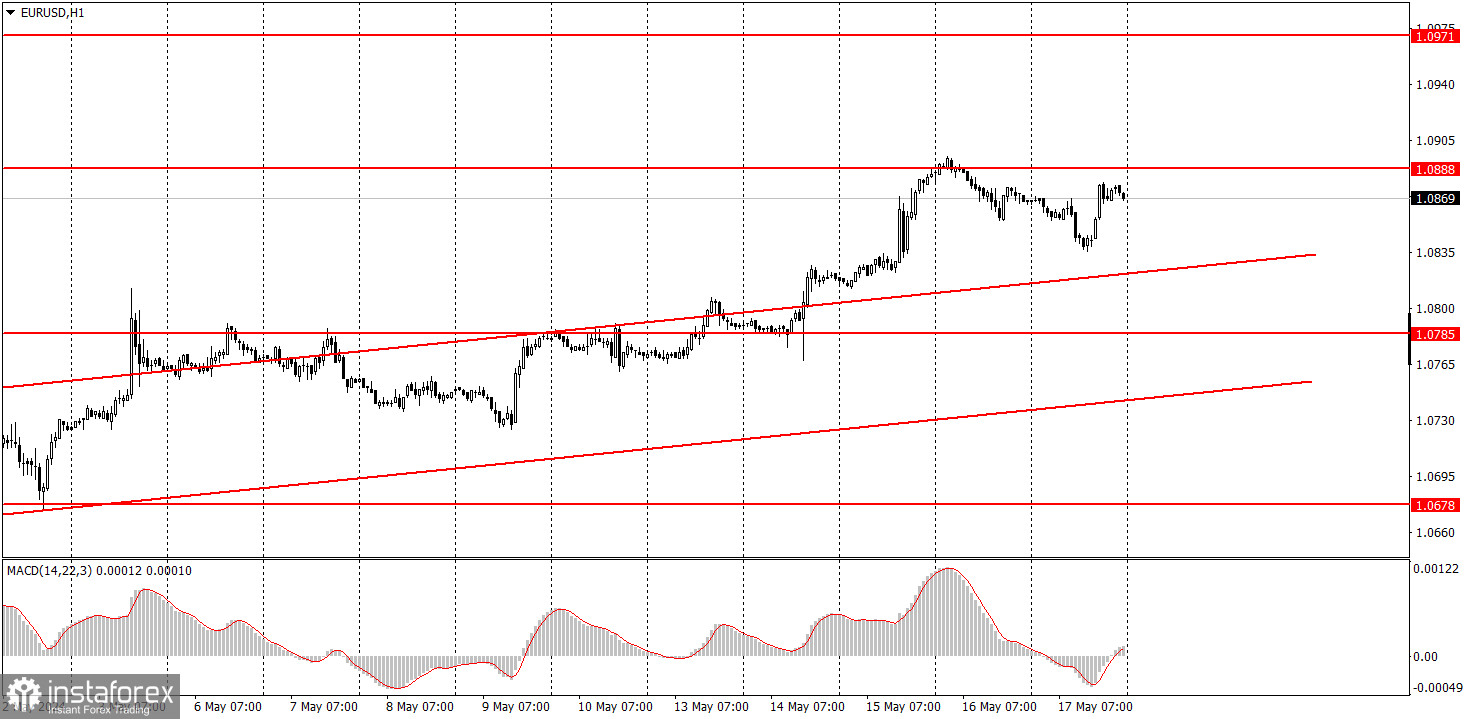Analyzing Friday's trades:
EUR/USD on 1H chart

EUR/USD tried to extend a bearish correction on Friday, but as usual, it almost rose to the local high in the afternoon. As we repeatedly mentioned, the entire upward movement, which has been ongoing for more than a month, should be considered a correction. When switching to the 24-hour timeframe, it is clear that the preceding decline was stronger, meaning the current movement is a correction. Therefore, we are still dealing with a downward trend, not the other way around. The euro continues to appreciate without any formal reasons, and Friday is a vivid confirmation of this.
One of the European Central Bank representatives, Isabel Schnabel, said Friday that the central bank may slash interest rates in June. If her remarks managed to lift the euro, then the market is only reacting to the supporting factors for the euro and ignoring the factors for the dollar's rise, as several Federal Reserve officials have recently released statements that should have caused the US currency to rise.
EUR/USD on 5M chart

Volatility was low and two buy signals were formed on the 5-minute timeframe. First, the pair bounced off the level of 1.0856, and then off the area of 1.0838-1.0856. These signals duplicated each other, so only one long position should have been opened. During the US trading session, the pair managed to edge up by about 10-15 pips, which novice traders could have earned.
Trading tips on Monday:
On the hourly chart, the EUR/USD pair continues to correct higher, which increasingly resembles an independent trend. We believe that the decline should resume in the medium term, as the euro remains expensive, and the overall trend is downward. However, for unknown reasons, the market refuses to buy the dollar.
On Monday, novice traders can look for signals around the areas of 1.0838-1.0856 and 1.0888-1.0896. These are fairly strong areas that can generate both buy and sell signals.
The key levels on the 5M chart are 1.0483, 1.0526, 1.0568, 1.0611, 1.0678, 1.0725-1.0733, 1.0785-1.0797, 1.0838-1.0856, 1.0888-1.0896, 1.0940, and 1.0971-1.0981. Today, there are no important events scheduled in either the US or the Eurozone, so we are in for another "boring Monday."
Basic trading rules:
1) Signal strength is determined by the time taken for its formation (either a bounce or level breach). A shorter formation time indicates a stronger signal.
2) If two or more trades around a certain level are initiated based on false signals, subsequent signals from that level should be disregarded.
3) In a flat market, any currency pair can produce multiple false signals or none at all. In any case, the flat trend is not the best condition for trading.
4) Trading activities are confined between the onset of the European session and mid-way through the U.S. session, after which all open trades should be manually closed.
5) On the 30-minute timeframe, trades based on MACD signals are only advisable amidst substantial volatility and an established trend, confirmed either by a trendline or trend channel.
6) If two levels lie closely together (ranging from 5 to 15 pips apart), they should be considered as a support or resistance zone.
How to read charts:
Support and Resistance price levels can serve as targets when buying or selling. You can place Take Profit levels near them.
Red lines represent channels or trend lines, depicting the current market trend and indicating the preferable trading direction.
The MACD(14,22,3) indicator, encompassing both the histogram and signal line, acts as an auxiliary tool and can also be used as a signal source.
Significant speeches and reports (always noted in the news calendar) can profoundly influence the price dynamics. Hence, trading during their release calls for heightened caution. It may be reasonable to exit the market to prevent abrupt price reversals against the prevailing trend.
Beginning traders should always remember that not every trade will yield profit. Establishing a clear strategy coupled with sound money management is the cornerstone of sustained trading success.
 English
English 
 Русский
Русский Bahasa Indonesia
Bahasa Indonesia Bahasa Malay
Bahasa Malay ไทย
ไทย Español
Español Deutsch
Deutsch Български
Български Français
Français Tiếng Việt
Tiếng Việt 中文
中文 বাংলা
বাংলা हिन्दी
हिन्दी Čeština
Čeština Українська
Українська Română
Română

